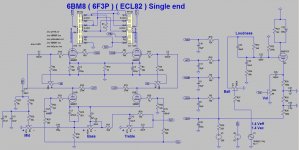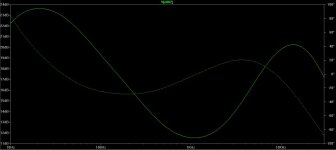For any of those wonderful modelers out there, what methods do you use to create spice models for pentodes that don't supply triode connection charts? I've created a handful in PaintKIP but I can't seem to model the screen current correctly.
Also, what methods are used to create diode/rectifier tube models?
Thanks,
Sam N.
Also, what methods are used to create diode/rectifier tube models?
Thanks,
Sam N.
I could never make a pentode model with PaintKIP either, and without triode-connected characteristic, Ayumi's method does not work either.For any of those wonderful modelers out there, what methods do you use to create spice models for pentodes that don't supply triode connection charts? I've created a handful in PaintKIP but I can't seem to model the screen current correctly.
Most if not all of the popular VR models have already been made, which you can download from Intact Audio's forum, if you must make one yourself, you can try to use one of the triode curve fitting apps.Also, what methods are used to create diode/rectifier tube models?
ECC40 Model
Hi,
Has anyone created a PSPICE (LTSpice) model for the ECC40 tube? Or know where one can be found?
I can try to create one using Ayumi's procedure if not...thought I'd try the cheap way first though....
😀
Thanks,
Gary
Hi,
Has anyone created a PSPICE (LTSpice) model for the ECC40 tube? Or know where one can be found?
I can try to create one using Ayumi's procedure if not...thought I'd try the cheap way first though....
😀
Thanks,
Gary
Last edited:
6386 Remote Cut-Off Triode SPICE Model
Code:
*
* Generic triode model: 6386_AN
* Copyright 2003--2008 by Ayumi Nakabayashi, All rights reserved.
* Version 3.10, Generated on Mon Jan 12 20:59:44 2015
* Plate
* | Grid
* | | Cathode
* | | |
.SUBCKT 6386_AN A G K
BGG GG 0 V=V(G,K)+1
BM1 M1 0 V=(1.0416187*(URAMP(V(A,K))+1e-10))**-30.188951
BM2 M2 0 V=(0.04733511*(URAMP(V(GG)+URAMP(V(A,K))/0.91460038)+1e-10))**31.688951
BP P 0 V=0.0012421239*(URAMP(V(GG)+URAMP(V(A,K))/19.321818)+1e-10)**1.5
BIK IK 0 V=U(V(GG))*V(P)+(1-U(V(GG)))*2.839322e+36*V(M1)*V(M2)
BIG IG 0 V=0.00062106195*URAMP(V(G,K))**1.5*(URAMP(V(G,K))/(URAMP(V(A,K))+URAMP(V(G,K)))*1.2+0.4)
BIAK A K I=URAMP(V(IK,IG)-URAMP(V(IK,IG)-(0.00071872818*URAMP(V(A,K))**1.5)))+1e-10*V(A,K)
BIGK G K I=V(IG)
* CAPS
CGA G A 1.2p
CGK G K 2p
CAK A K 1.1p
.ENDSECC40 SPICE Model
Code:
*
* Generic triode model: ECC40_AN
* Copyright 2003--2008 by Ayumi Nakabayashi, All rights reserved.
* Version 3.10, Generated on Mon Jan 12 21:20:25 2015
* Plate
* | Grid
* | | Cathode
* | | |
.SUBCKT ECC40_AN A G K
BGG GG 0 V=V(G,K)+0.69380796
BM1 M1 0 V=(0.011130011*(URAMP(V(A,K))+1e-10))**-0.63758826
BM2 M2 0 V=(0.70172541*(URAMP(V(GG)+URAMP(V(A,K))/26.799128)+1e-10))**2.1375883
BP P 0 V=0.0015916545*(URAMP(V(GG)+URAMP(V(A,K))/38.190334)+1e-10)**1.5
BIK IK 0 V=U(V(GG))*V(P)+(1-U(V(GG)))*0.00092247006*V(M1)*V(M2)
BIG IG 0 V=0.00079582725*URAMP(V(G,K))**1.5*(URAMP(V(G,K))/(URAMP(V(A,K))+URAMP(V(G,K)))*1.2+0.4)
BIAK A K I=URAMP(V(IK,IG)-URAMP(V(IK,IG)-(0.00085875006*URAMP(V(A,K))**1.5)))+1e-10*V(A,K)
BIGK G K I=V(IG)
* CAPS
CGA G A 2.7p
CGK G K 2.8p
CAK A K 1.1p
.ENDSTry this model Gary. If there is no good, I'm guilty😀
**** ECC40**************************
* Created on 04.12.2013 23:53 using paint_kit.jar Version 2.4.7 Oct 2013
* Model Paint Tools: Trace Tube Parameters over Plate Curves, Interactively
* Plate Curves image file: ecc40.jpg
*----------------------------------------------------------------------------------
.SUBCKT ECC40 1 2 3 ; Plate Grid Cathode
+ PARAMS: CCG=2.8P CGP=2.7P CCP=1.1P RGI=2000
+ MU=32.8 KG1=1164.9 KP=292 KVB=324.7 VCT=0.328 EX=1.35
* Vp_MAX=500 Ip_MAX=15 Vg_step=2 Vg_start=0 Vg_count=14
* Rp=4000 Vg_ac=55 P_max=2 Vg_qui=-48
* X_MIN=33 Y_MIN=80 X_SIZE=570 Y_SIZE=343 FSZ_X=1032 FSZ_Y=742 XYGrid=false
*----------------------------------------------------------------------------------
E1 7 0 VALUE={V(1,3)/KP*LOG(1+EXP(KP*(1/MU+(VCT+V(2,3))/SQRT(KVB+V(1,3)*V(1,3)))))}
RE1 7 0 1G ; TO AVOID FLOATING NODES
G1 1 3 VALUE={(PWR(V(7),EX)+PWRS(V(7),EX))/KG1}
RCP 1 3 1G ; TO AVOID FLOATING NODES
C1 2 3 {CCG} ; CATHODE-GRID
C2 2 1 {CGP} ; GRID=PLATE
C3 1 3 {CCP} ; CATHODE-PLATE
D3 5 3 DX ; POSITIVE GRID CURRENT
R1 2 5 {RGI} ; POSITIVE GRID CURRENT
.MODEL DX D(IS=1N RS=1 CJO=10PF TT=1N)
.ENDS
*$
**** ECC40**************************
* Created on 04.12.2013 23:53 using paint_kit.jar Version 2.4.7 Oct 2013
* Model Paint Tools: Trace Tube Parameters over Plate Curves, Interactively
* Plate Curves image file: ecc40.jpg
*----------------------------------------------------------------------------------
.SUBCKT ECC40 1 2 3 ; Plate Grid Cathode
+ PARAMS: CCG=2.8P CGP=2.7P CCP=1.1P RGI=2000
+ MU=32.8 KG1=1164.9 KP=292 KVB=324.7 VCT=0.328 EX=1.35
* Vp_MAX=500 Ip_MAX=15 Vg_step=2 Vg_start=0 Vg_count=14
* Rp=4000 Vg_ac=55 P_max=2 Vg_qui=-48
* X_MIN=33 Y_MIN=80 X_SIZE=570 Y_SIZE=343 FSZ_X=1032 FSZ_Y=742 XYGrid=false
*----------------------------------------------------------------------------------
E1 7 0 VALUE={V(1,3)/KP*LOG(1+EXP(KP*(1/MU+(VCT+V(2,3))/SQRT(KVB+V(1,3)*V(1,3)))))}
RE1 7 0 1G ; TO AVOID FLOATING NODES
G1 1 3 VALUE={(PWR(V(7),EX)+PWRS(V(7),EX))/KG1}
RCP 1 3 1G ; TO AVOID FLOATING NODES
C1 2 3 {CCG} ; CATHODE-GRID
C2 2 1 {CGP} ; GRID=PLATE
C3 1 3 {CCP} ; CATHODE-PLATE
D3 5 3 DX ; POSITIVE GRID CURRENT
R1 2 5 {RGI} ; POSITIVE GRID CURRENT
.MODEL DX D(IS=1N RS=1 CJO=10PF TT=1N)
.ENDS
*$
Code:* * Generic triode model: ECC40_AN ... .ENDS
Try this model Gary. If there is no good, I'm guilty😀
**** ECC40**************************
*$
Thanks guys! Will let you know how they work out.
I tried to make one with a set of curves I found over at Intact Audio, but it was not accutate at all when compared against the datasheet. So if you have the tubes on hand, could you please plot some triode-connected curves? I can use the data to make you a tetrode model.An odd bird I know, but does anybody have a LTSpice model for this?
13E1 tetrode model
Jazbo, many thanks, it will be a few weeks before I can post the data because I'm on holiday.
Forgive my ignorance, but can you explain how a tetrode model is derived from triode data?
Jazbo, many thanks, it will be a few weeks before I can post the data because I'm on holiday.
Forgive my ignorance, but can you explain how a tetrode model is derived from triode data?
Are you still thinking about tubes on your holiday?😀 Well, the model is created with the Ayumi method, which is based on the fact that the triode/cathode current contains both the anode and screen current. Therefore by applying the proper ratios to the cathode current, both anode and screen current could be derived. This seems to work much better than the results from curve fitting the beam tetrode/pentode characteristic.Jazbo, many thanks, it will be a few weeks before I can post the data because I'm on holiday.
Forgive my ignorance, but can you explain how a tetrode model is derived from triode data?
Last edited:
Jazbo, I am thinking about what will keep me distracted from my work when I return from holiday, so I am guilty as charged! I will post the triode curves when I get back as an Excel spreadsheet. Remarkably when I tested my batch of 13E1s first up in tetrode mode there was almost no sample variation so it should be a fairly quick task for me to get some good data.
Thanks again and back to paying attention to South East Asia not tubes !
Thanks again and back to paying attention to South East Asia not tubes !
Hi jazbo8, I don't have it but if you can get a good 7199 pentode model, you can just plug it in your schematic like a triode and you will get exactly the same results. I verify many Ayumi pentodes "triode connected" models and I compare them to is pentode model triode connected directly in the schematic. 😉Does anyone have a traced triode curve for the pentode section of the 7199?
None of the 7199 model I found even work as pentode let alone as triode.Hi jazbo8, I don't have it but if you can get a good 7199 pentode model, you can just plug it in your schematic like a triode...
- Home
- Amplifiers
- Tubes / Valves
- Vacuum Tube SPICE Models

